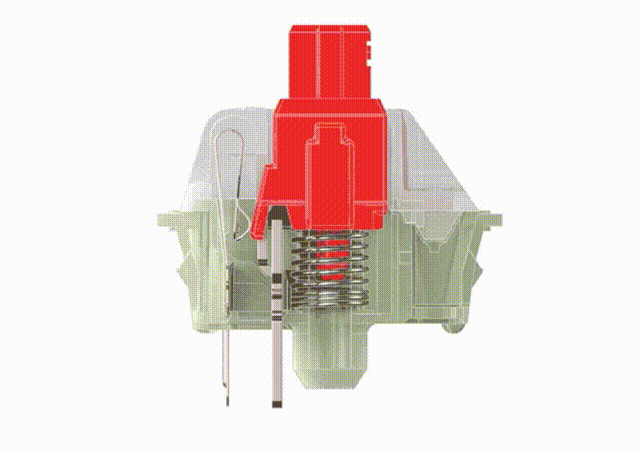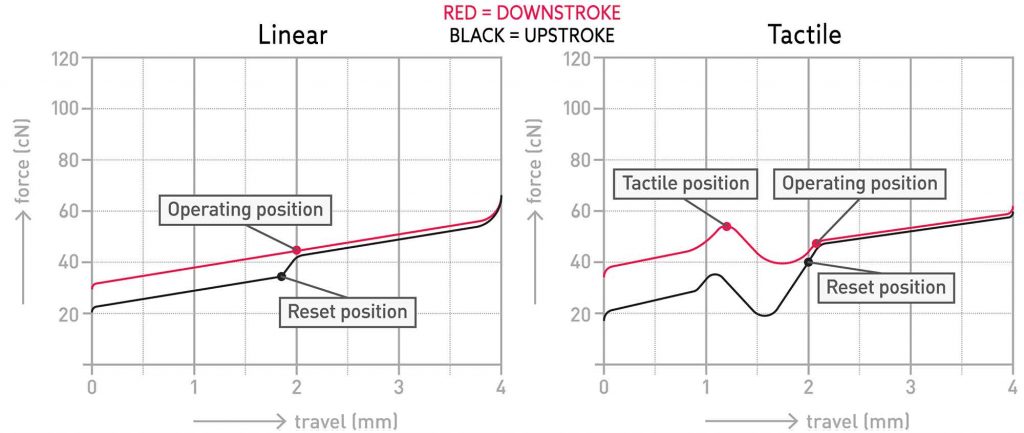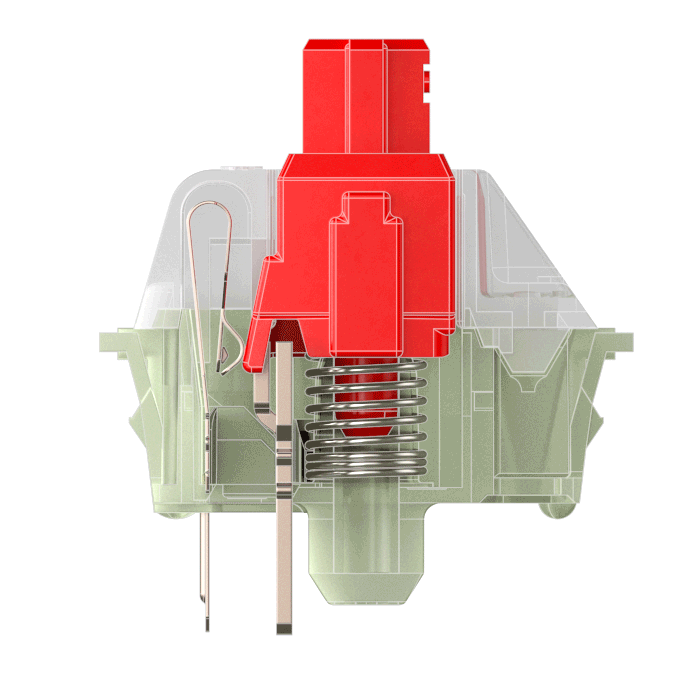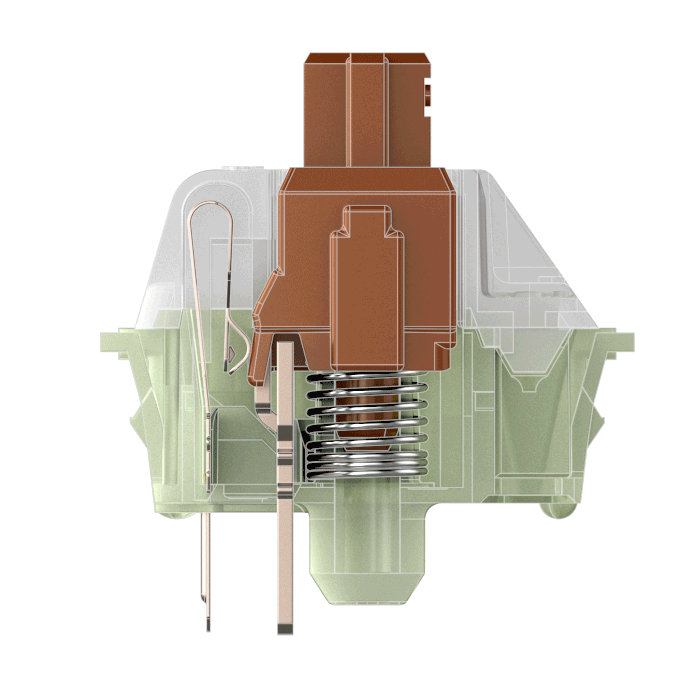Difference Between Linear And Tactile Switches

Mechanical keyboard switches directly touch on performance, then many gamers and typists carefully compare linear vs. tactile switches to see which is best for their needs. This guide makes the decision easier by clarifying the differences between linear and tactile switches.
Linear vs Tactile Switches: Quick Comparison

Use the tabular array to compare the main differences between linear and tactile switches. Scroll down for boosted details.
| Linear Switches | Tactile Switches | |
| Keystroke Feel | Smoothen and consequent | Slight bump |
| Tactile Feedback | No | Aye |
| Audio | Noiseless | Serenity |
| Fundamental Reward | Speed | Accuracy |
| All-time For (In Full general) | Gaming | Typing |
Linear Switches Are Smooth and Consistent

Linear switches offer a smooth, consistent bump-costless experience throughout each keystroke. Many people feel those qualities make linear switches platonic for gaming when tactile feedback could slightly reduce speed and increase response time. That'due south anecdotal, but it's worth noting that loftier-finish linear switches such as the Ruby-red MX Reddish and Cherry MX Speed Silverish are oftentimes regarded equally the best for gaming and speed.
Different clicky switches, linear switches are noiseless, so they won't bother coworkers in shared workspaces or frustrate followers during video recordings or alive streams. That said, keycaps can however ballyhoo if they're bottomed out.
The lack of feedback can represent a learning curve for those accepted to clicky or tactile switches, particularly if they don't feel their keystrokes are registering. That could pb to inaccuracies until they go used to linear switches.
Linear Switch Advantages
- Polish, soft-bear on
- Consistent keystroke
- Noiseless
- Speed
- Generally considered all-time for gaming
Linear Switch Considerations
- No tactile feedback
- Reduced accuracy through the learning curve
Popular Linear Switches
- Cherry MX Red
- Cherry MX Speed Silver
- Ruby-red MX Black
- Ruby MX Silent Cherry-red
- Cherry MX Low Profile Speed
- Gateron Red
- Gateron Yellow
- Gateron Ink Blackness
- Kailh Ruby-red
- Kailh Black
Tactile Switches Offer Tangible Feedback

When you press a tactile switch and experience a satisfying bump partway through the keystroke. That bump offers instant, tangible feedback that lets users know their keystrokes are registered. Tactile switches such as the Cherry MX Dark-brown are considered splendid for all-purpose use, and many people say the bump makes tactile switches all-time for typing.
Clicky switches could be considered a subset of tactile switches since they as well provide feedback. But tactile switches are placidity, so they're good for shared workspaces and video recording, while clicky switches are designed to deliver an aural click that could bother others. Cherry MX Bluish and Cherry MX Green switches, for example, are regarded as two of the best switches for typing. Both are clicky switches with tactile feedback. Tactile switches might help reduce typos, peculiarly for those with twitchy fingers, since they tell users precisely when each keystroke registers, while others feel that the tactility reduces their typing speed.
Tactile Switch Advantages
- Instant, tangible feedback
- Satisfying crash-land
- Quiet
- Accuracy
- Generally considered best for typing and all-purpose utilize
Tactile Switch Considerations
- Inconsistent feel through keystrokes
- Potentially reduced speed
Pop Tactile Switches
- Red MX Brown
- Reddish MX Clear
- Cherry MX Grey
- Das Keyboard Gamma Zulu Soft
- Gateron Brown
- Kailh Brown
- Kaihl Speed Copper
- Boba U4
- Glorious Panda
- Durok T1
Linear vs. Tactile Switches: Common Misconceptions
Three misconceptions tend to pop upwardly when comparing tactile to linear switches.
ane. Linear and Tactile Switches Have Unlike Resistance
Some manufactures state that tactile switches have greater resistance than linear switches, which means they can slow response times. Information technology'due south of import to note that "linear" and "tactile" refer to actuation types, not resistance ratings.
For example, Ruddy MX Browns are tactile switches with 55 cN (centinewton) resistance. Cherry MX Blacks are linear switches with 60 cN resistance. The linear switch has greater resistance than the tactile switch in this comparing.
Linear switches do tend to have less resistance than tactile switches (Ruby MX Reds and Cherry MX Speed Silvers are both 45 cN), only that isn't true with every model.
ii. Travel Distance
Similarly, some erroneously state that linear switches have less travel distance than tactile switches, making linear switches faster and more responsive. Again, that doesn't stand true across the board in real-earth comparisons.
For example, the Cherry MX Brown tactile switch features a two.0 mm pre-travel distance and four.0 mm total travel, the same as two popular linear switches: the Cherry MX Crimson and Cherry MX Blackness.
That said, mechanical keyboard switch manufacturers do reduce travel distance to meliorate speed. The Cherry MX Speed Silvery, for instance, has a 1.2 mm pre-travel distance and iii.4 mm total travel. That said, travel distance alone isn't a differentiator betwixt linear and tactile switches.
3. Colors
Carmine MX switch stems are famously colour-coded by switch type, and other manufacturers such as Gateron and Kaihl tend to utilize the aforementioned colors to help buyers understand what kind of switches they're getting:
- Linear: Ruddy, yellow and black stems
- Tactile: Brown, grey, and clear stems
- Clicky: Bluish and green stems
The color of a switch isn't always a reliable style to identify a linear switch from a tactile switch. For instance, the Gateron Yellow is a linear switch, while the Glorious Panda is a tactile switch. Both have yellow stems. Companies also make switches with stem colors non found in the current Ruby-red MX lineup, including pink, orange, and white.
How to Choose Betwixt Linear vs Tactile Switches
Both linear and tactile switches offering unique characteristics designed to enhance mechanical keyboard operation. Though some say linear switches are best for gaming and tactile switches are best for typing, neither type of switch is inherently amend than the other. Ultimately, the choice comes downwardly to personal preference.
If you adopt a smoothen, consistent, bump-costless, and noiseless keystroke, linear switches might exist the best pick. Tactile switches are a great choice if you like an instant, tangible, yet tranquillity feedback with every keystroke.
Do your inquiry and avoid generalizations and misconceptions that could crusade you to buy the wrong switches. If y'all tin, requite both switches a endeavor earlier yous buy. Taking them for a test run is the best fashion to tell which blazon of switch you prefer and mayhap you'll find a new favorite feel for typing or coding.
Source: https://www.daskeyboard.com/blog/difference-between-linear-vs-tactile-switches/

0 Response to "Difference Between Linear And Tactile Switches"
Post a Comment